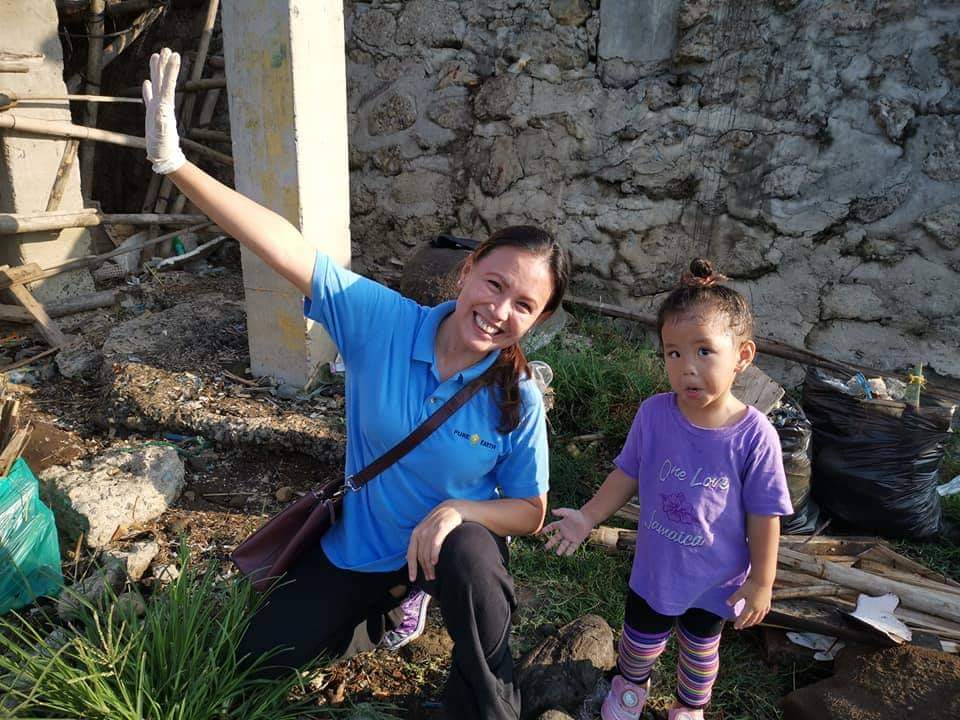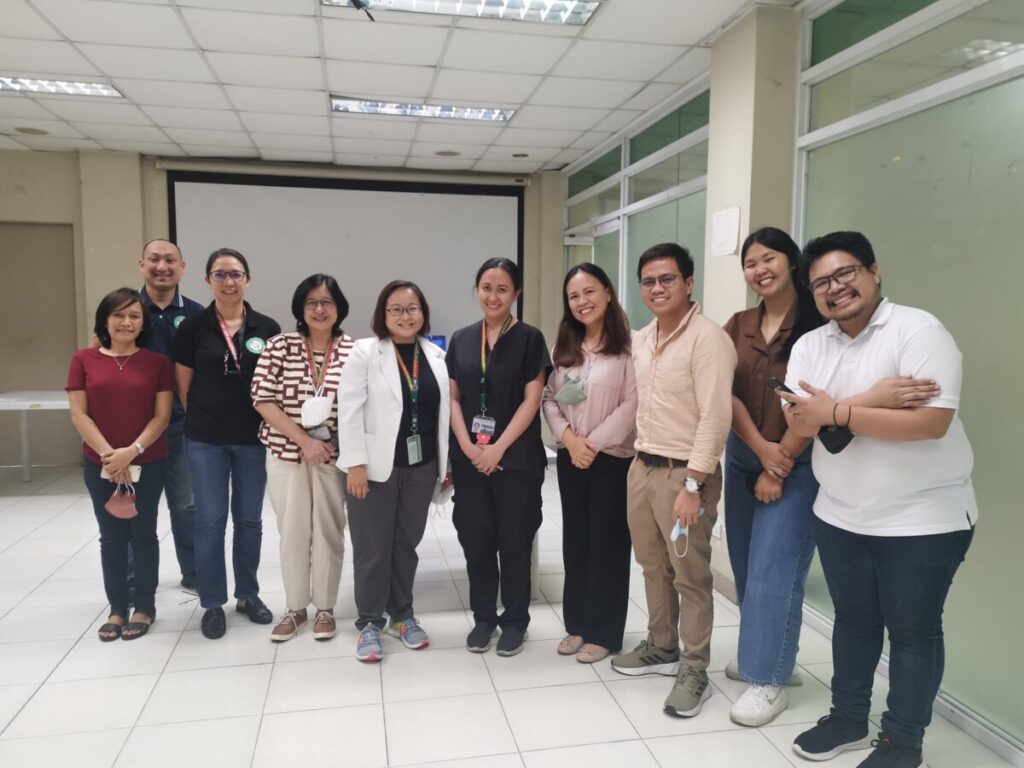This post is by Larah Ortega Ibañez, the country director for Pure Earth Philippines, who shares updates on the work taking place in her country. Learn more about Pure Earth Philippines.

I believe good comes from hard and heart work.
That’s why I’m proud to be part of Pure Earth Philippines, a team willing to put in the hard work, motivated by big hearts beating for the greater good.
My predecessors, Prof. Marlo Mendoza and Dr. Jennifer Marie Sunga-Amparo, were among the most indefatigable, excellent leaders in their fields. Our consultants through the years, including Dr. Veronica Migo, Dr. Lorele Trinidad, Dr. Catalino Alfafara, and our current public health and toxicology consultant Dr. Lynn Crisanta Panganiban, have all been the go-to-experts in the country, and yet they have admirably remained grounded.
It is worth noting that while we often work in challenging situations, addressing toxics with meager resources, the staff who work with and for Pure Earth in one way or another (mostly from the Department of Social Development Services, in the College of Human Ecology, at the University of the Philippines, Los Baños) have carried the cause forward in their respective profession. I would name them one by one if only this space would allow. It’s been an honor to have known and worked with them.
Currently, Elezabeth Ompad, a chemical engineer, now serves as our multi-tasking and dependable Environment Program Officer. Joining our team is our new Health Program Officer Danwell Esperas, a nurse moved by the plight of the most vulnerable populations, hence his engagement in development work.
As a graduate of public administration, who served a few years at the ABS-CBN Foundation, Inc., I was at first intimidated by all the science required in my work with Pure Earth. But now I direct Pure Earth’s environmental health efforts, knowing I’m privileged to work with such a committed local and international team. It’s been 11 years since I joined.
It hasn’t been easy working to solve pollution problems where human health is at risk. Pollution is such a complicated issue. In countries like ours, where there are a host of other competing priorities, there seems to be an unfortunate acceptance of the feeling that nothing can be done.
That is the greatest challenge and the biggest frustration of all… to not be able to accomplish things as efficiently as possible because you are dealing with a situation that you aren’t in control of on many levels. There is a general lack of understanding about pollution and its impacts on environment, health and economics, and a lack of understanding about the amount of time, effort and resources needed, and the level of perseverance necessary to see the solution through to the end and sustain it.
For us at Pure Earth, the steps are clear: gather as much data about the problem as possible; communicate the findings to stakeholders; co-plan and implement appropriate, science-based interventions; pioneer if we must, then document and share the challenges and best practices, and keep on doing so until critical policies and programs are integrated in governance towards sustainability.
In principle, it’s clear cut. In actual execution, it can be pretty complicated. Now, it makes sense what I said earlier, you really have to have people not only with the heads and hands for the job, but also, most importantly, the heart for the job.
Pure Earth operations in the country started in 2007, with assessments of the Marilao-Meycauayan-Obando River System, which led to the controversial inclusion of the area in the 2008 “Dirty 30” report, which was published by Blacksmith Institute, which later became Pure Earth.
On one hand, this spurred action towards its declaration as a Water Quality Management Area (WQMA), and led to the creation of a WQMA governing board and a ten-year action plan. On the other hand, I learned that if the level of commitment to determine, implement, monitor and evaluate, and sustain data-informed political and programmatic actions from key stakeholders isn’t there, we will not get anywhere significant, no matter how hard we pursue it.
When I joined Pure Earth in 2012, we had one project that focused on the area. Five years later, when the situation remained as challenging despite our dedicated initiatives, I knew that we had to re-strategize. I wanted to ensure that local commitment was involved because that was the only way we could achieve a measurable impact with our limited time and resources. On this note, I consider the following as some of our key accomplishments:
- Community exposure mitigation of a lead contaminated site in San Simon, Pampanga, resulting in the protection of families from poisoning (watch the video below);
- A Toxic Sites Identification Program investigation in Iloilo City and Tagbilaran City resulting in the inclusion of data into local plans, regulatory policy and enforcement.
We’ve proven that local commitment is indeed critical to any intervention’s success.
Before I go, I want to spotlight our proudest achievement so far: the pilot inclusion of blood lead level testing in the National Nutrition Survey of the Philippines and its resulting next steps.
The pandemic years gave us time to step back and slow down for a purpose-–to learn from and build on our past site-specific challenges and successes, and to think through where we’re headed to achieve measurable impact on a national scale.
The thought of focusing on lead, digging deeper into previous local studies and initiatives, gathering our own national baseline data in order to understand the current scenario on the prevalence of lead poisoning as well as its exposure sources, and then developing, piloting and institutionalizing a monitoring and surveillance system came to mind. In 2020, we started making strides towards this end, and you can see our milestones below. Take a look and who knows? We might be able to work on something significant together in the future!
Project Highlights
Blood lead level (BLL) survey of around 3000 children ages 6 through 9 and pregnant women in 25 sites across the country in partnership with the Food and Nutrition Research Institute of the Department of Science and Technology.
The first phase was done in 13 areas. A majority of the children had blood lead levels below the detection limit of 2 ug/dL, while 202 or 26% of 775 children had detectable blood lead levels ranging from 2 to 11.16 ug/dL, and only 64 or 8% went above the US CDC action level of 3.5 ug/dL. We will be updating the report to include the results from the remaining 12 areas.
Results analysis and health consultations for BLL survey participants. This includes sending out feedback forms in sealed envelopes to all participants and offering either face to face or teleconsultations with Dr. Lynn Panganiban and her colleagues who are toxicology doctors and fellows at the National Poison Control Management and Control Center of the University of The Philippines General Hospital.
This part of the process is extremely challenging but it is heartwarming to receive comments like “We’re grateful Pure Earth came back to talk to us about our results and advise us on what we can do to protect our children,” from participants. We’re also seeing growing interests from health officers of local government units in learning how they can take these efforts forward in their own localities with their own personnel and resources.
This video documents in detail what we do in face-to-face health consultations.
https://youtu.be/FyRg2O3FYPY
Home-based assessments to determine exposure sources in the homes of those with BLL determinations. This is a follow through of our Rapid Market Screening (RMS) project, in which we surveyed public and private markets in the Philippines for consumer products possibly contaminated by lead. The RMS revealed the presence of lead in aluminum cookware, ceramics, cosmetics, toys, paints and spices ranging from 1 to 41,800 ppm based on X-ray Fluorescence readings. We are yet to find out if these will be consistent with what we’ll find in the homes of affected children. This is also a follow through service for the BLL survey to help us best identify solutions for specific sources of exposure. To give a snapshot of how we’re doing this, here’s another video from the field.
Capacity building. We are currently finishing the capacity assessment report for the Philippines and are about to conduct laboratory capacity surveys and develop the criteria for our pilot areas for the capacity development and the monitoring and surveillance system that we hope to put in place to protect Filipino children from lead poisoning.
We still have a lot to do. But it’s all good. And as I said at the beginning, all good work takes hard and heart work. So, we will keep soldiering on. If you or your organization share the same passion, we’d be happy to welcome a helping hand.




